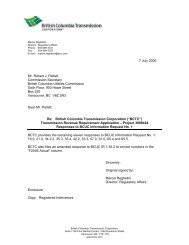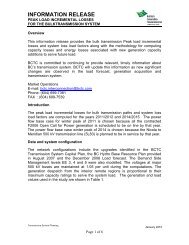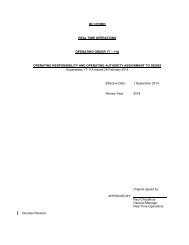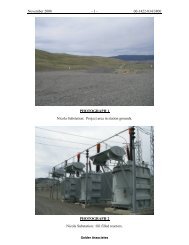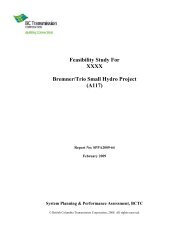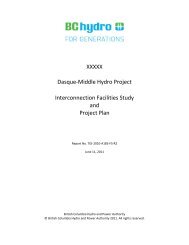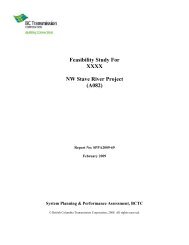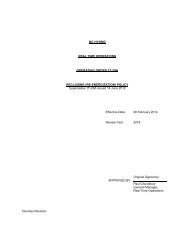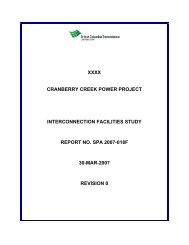Evidence on the Adequacy of First Nations Consultation - BC Hydro ...
Evidence on the Adequacy of First Nations Consultation - BC Hydro ...
Evidence on the Adequacy of First Nations Consultation - BC Hydro ...
You also want an ePaper? Increase the reach of your titles
YUMPU automatically turns print PDFs into web optimized ePapers that Google loves.
Obviously, <strong>the</strong>se place names may also have been developed out <strong>of</strong> familial relati<strong>on</strong>ships or post<br />
c<strong>on</strong>tact employment in adjacent lands, and this may also have c<strong>on</strong>tributed to <strong>the</strong> evident overstating<br />
<strong>of</strong> Shuswap and Sinixt territories. 74<br />
Vibert 75 describes more generally how such mechanistic interpretati<strong>on</strong>s can be misleading:<br />
Not <strong>on</strong>ly did language not coincide with culture, it did not coincide so neatly with territory. Language<br />
was little obstacle to <strong>the</strong> movement <strong>of</strong> people, goods, and ideas in <strong>the</strong> Plateau…<br />
Before we leave Teit, it should also be noted that he authored an article c<strong>on</strong>cerning <strong>the</strong> origins <strong>of</strong> <strong>the</strong><br />
Ktunaxa 76 , at least a part <strong>of</strong> whom were living <strong>on</strong> <strong>the</strong> Plains before c<strong>on</strong>tact with whites and <strong>the</strong>ir<br />
resulting devastati<strong>on</strong> by smallpox and rifle bearing Blackfoot. Much <strong>of</strong> <strong>the</strong> article c<strong>on</strong>cerns <strong>the</strong> fate<br />
<strong>of</strong> <strong>the</strong> T<strong>on</strong>a’xa, who appear to have been a plains oriented Ktunaxa, possibly associated with <strong>the</strong><br />
Michel Plains Ktunaxa. In this regard, he menti<strong>on</strong>s that in pre-c<strong>on</strong>tact time, Ktunaxa may have<br />
occupied porti<strong>on</strong>s <strong>of</strong> southwestern Alberta:<br />
The Piegan claim that before <strong>the</strong> white man dominated <strong>the</strong>ir country, <strong>the</strong> Blackfoot, Blood and Piegan<br />
lived north <strong>of</strong> Macleod; <strong>the</strong> Kutenai in <strong>the</strong> vicinity <strong>of</strong> <strong>the</strong> present Blood Reserve.<br />
3. Claude E. Schaeffer<br />
As a less published ethnographer, Schaeffer is not as well known in <strong>the</strong> field as some o<strong>the</strong>rs, but in<br />
<strong>the</strong> late 1930s, working around <strong>the</strong> same time as Turney-High, he assembled a very large and<br />
valuable collecti<strong>on</strong> <strong>of</strong> field notes <strong>on</strong> <strong>the</strong> Ktunaxa, which he ultimately c<strong>on</strong>verted into some nine<br />
volumes <strong>of</strong> typescript notes. Although research has yet to discover a map <strong>of</strong> his that delineates<br />
aboriginal territories, he recorded valuable informati<strong>on</strong> relevant to our purposes from his many<br />
informants, who generally indicated an abundance <strong>of</strong> fish and game in <strong>the</strong> Upper Columbia Valley,<br />
yet an impressively large Canadian range from <strong>the</strong> U.S. Border to Yellowhead Pass and east <strong>of</strong> <strong>the</strong><br />
Rockies.<br />
Some <strong>of</strong> <strong>the</strong> main fishing spots <strong>on</strong> <strong>the</strong> upper Columbia were named [Vol. VII, p. 31]:<br />
"1. yakinasu'kwl `red water' (from story <strong>of</strong> water m<strong>on</strong>ster yawu'nik that was speared here). Name<br />
given to salm<strong>on</strong> fishing site at Briscoe, <strong>on</strong> <strong>the</strong> Columbia 77 . The Kutenai fished here in August and was<br />
first fishing <strong>of</strong> seas<strong>on</strong>, as <strong>the</strong>y followed <strong>the</strong> salm<strong>on</strong> up <strong>the</strong> Columbia River.<br />
2. roatqranur "where lake empties into river". A fishing site near Athalmer. This was a shallow place<br />
where <strong>the</strong> salm<strong>on</strong> spawned. This was last site at which Kutenai fished [for salm<strong>on</strong>?] in October.<br />
3. raras'ituk, "mouth <strong>of</strong> river". A fishing site at mouth <strong>of</strong> Coldspring Creek where it empties into<br />
Columbia, not far from Fairm<strong>on</strong>t Springs. Kutenai fished here in September, following fishing at<br />
Briscoe. (Coldspring Creek or Dutch Creek?).<br />
4. kotwa.akak, "berries <strong>of</strong> rosebush". A site <strong>on</strong> north side <strong>of</strong> Geary Creek, where it empties into<br />
Columbia. Kutenai speared Salm<strong>on</strong> here.<br />
Louis Arbell, who appears to have been a highly valued informant judging by <strong>the</strong> number <strong>of</strong><br />
references, claimed that:<br />
74 For example, we call <strong>the</strong> capital <strong>of</strong> Russia “Moscow”, but that doesn’t mean we can claim “Moskva” [<strong>the</strong> Russian<br />
pr<strong>on</strong>unciati<strong>on</strong>] as part <strong>of</strong> Canada.<br />
75 Vibert, Traders’ Tales, p. 30.<br />
76 Teit, Traditi<strong>on</strong>s regarding <strong>the</strong> T<strong>on</strong>a'xa America Anthropologist, Volume unknown, pp. 625-632, 1930. The Blood<br />
Reserve is located at Cardst<strong>on</strong>, in <strong>the</strong> southwest corner <strong>of</strong> Alberta.<br />
77 Brisco is about midway between <strong>the</strong> Windermere and Golden.<br />
36<br />
Page 180 <strong>of</strong> 200






